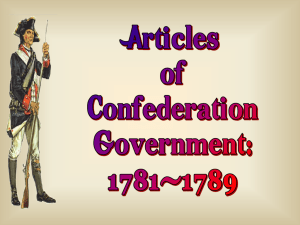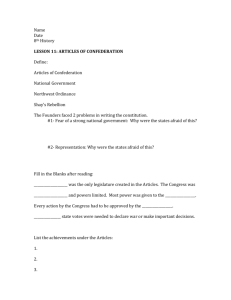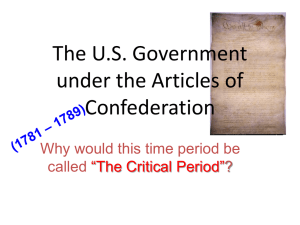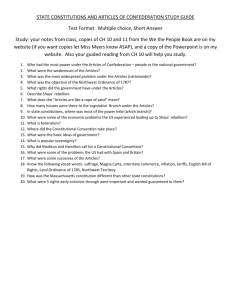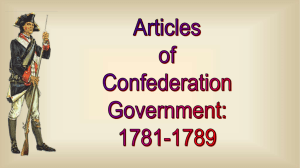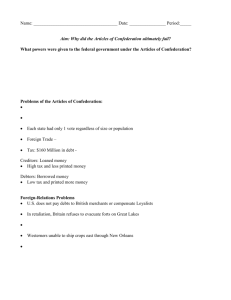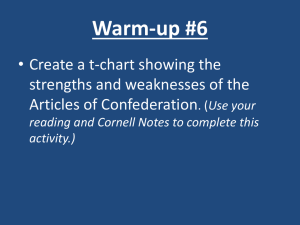"Good Start" OR "Growing Pains"?
advertisement
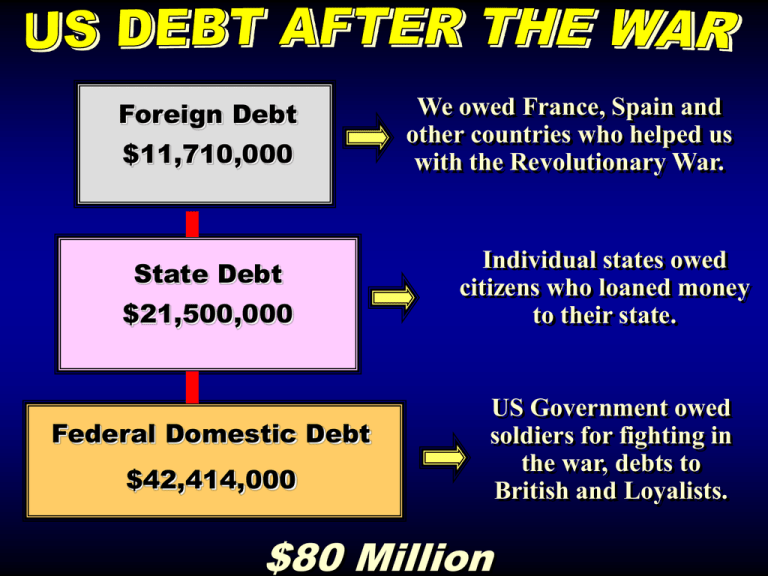
Foreign Debt
We owed France, Spain and
other countries who helped us
with the Revolutionary War.
$11,710,000
Individual states owed
citizens who loaned money
to their state.
State Debt
$21,500,000
US Government owed
soldiers for fighting in
the war, debts to
British and Loyalists.
Federal Domestic Debt
$42,414,000
$80 Million
debt
British were to remove their troops from US soil…..The National Government
under the Articles of Confederation was powerless to force Great Britain to honor
the Treaty of Paris, 1783
Jays
Disputed Territorial Claims
Between Spain & the US: 1783-1796
State Claims to Western Lands
“All Men Created
Equal”
•New England states are the
first to abolish slavery after
the Revolution.
•Middle States would abolish
later….
•In 1791, the Quakers
formed first Anti-Slavery
Society and Underground
Railroad
•Southern States would
expand slavery after the
invention of the cotton gin.
•As country expands, North
and South would
compromise over the issue of
slavery……
“All Men Created Equal”
•Mason Dixon Line
set the precedent over
dividing the country
over slavery.
•Ohio River would be
the dividing boundary
between North and
South.
•Abigail Adams—1790s to early 1800s
•Elizabeth Cady Stanton and Susan B.
Anthony---1830s
1900s
Republicantomotherhood
• Concept that
a woman’s
role was to stay at
•Women’s
rights
reformers
home and raise the next generation of PATRIOTS.
•citizenship
•This
was a role to be proud of because a
woman’s
•rightresponsibility
to vote was to teach and raise
their children in REPUBLICANISM.
•education
•Supported the abolition of slavery
•Republican motherhood
•Despite their contributions, women’s
rights did not progress and would
Picture/Anthony
& Stanton
remain
2nd class
citizens
•13 colonies had a tradition of
governing themselves…..
•Elected their own representative law
making bodies.
•Passed laws to keep peace within
their communities.
• Colonies had a tradition of
representative democracy.
•That’s why they fought the
Revolution.
State Features
Constitutions
Common
of State
1. Popular sovereignty was the basis for every new
Constitutions
State constitution.
Popular
2.
Sovereignty
3.
Limited
Government
1.
2.
1.
Civil Rights
and Liberties
Separation of
Powers and
Checks and
Balances
2.
1.
2.
Government can exist and function only with the
consent of the governed.
People hold power and are sovereign.
Limited government was a major feature of each
State constitution.
Powers delegated to government were granted
reluctantly and hedged with many restrictions.
In every State it was made clear that the
sovereign people held certain rights that the
government must respect at all times.
Seven of the new constitutions contained a bill
of rights, setting out the “unalienable rights”
State governments were purposely divided
among three branches: executive, legislative,
and judicial.
Each branch was given powers with a system of
checks and balances.
A/C chart
•Our first constitution (law of the land)
and attempt to create a democratic
government based on the ideas of
Declaration of Independence.
•Written by 2nd Continental Congress
during War and took effect in March
1781… Becomes the Confederation
Congress
•Founding Fathers were determined not
to have a king…..
A/C chart
Confederation Government
government of loosely organized states
Each state independent and conducted their own
affairs
Created a weak national government which had
little powers to solve US problems
States held more power than US government
Would unite in times of crisis
“Treaty of Cooperation between the states”
Major Problem
Could not tax,
regulate trade or
enforce its laws
because the states
held more power
than the National
Government.
Why?
Feared a
government like
King George
Northwest
Territory
USA
Ohio
1ST STEP
2nd STEP
3rd STEP
WHEN PEOPLE
FIRST SETTLE IN
THE AREA:
5,000 FREE ADULT
MALES:
60,000 SETTLERS:
Congress appoints a
governor and three
judges to govern the
territory
Landowners elect a
congress to make laws
and raise taxes with
approval of governor. 1
representative is elected
to the US Congress who
can debate but not vote.
Becomes a state, with its
own government and
constitution. New states
admitted with same rights
as the original states. No
more than 5 states can
carved out of this area.
The Northwest Ordinance encouraged ideals of the Declaration of Independence
and republicanism (representative democracy) religious freedom, protection of
liberty and property, encouraged education, admitted new states and no slavery.
In early 1787 a group of small farmers protested against the
Massachusetts government.
Why? They were in debt, their homes being repossessed and
unfair taxation.
They were led by Daniel Shays, a former army captain in the
Revolutionary War.
The purpose of the rebellion was to prevent foreclosures by
keeping the courts from sitting until the next election.
Shays’ Rebellion was put down by private army paid for by
wealthy merchants from Boston.
The Articles of Confederation was unable to put down the
rebellion with a national guard or army.
total chaos, mob rule,
survival of the fittest, no
respect for law and order or
attempting to overthrow the
authority of government
= unstable government
= no govt.
notes3
“MOBOCRACY”
The Elites Response to
Shays’ Rebellion:
“Respectable”
Americans were
shocked by the
violence. Feared
“mobocracy”
Let us have
{ a Constitution }
by which our lives,
liberties and properties
will be secured....
The Elites Response to
Shays’ Rebellion
The Annapolis Convention (1786)
• George Washington hosted a conference at his home in Mt.
Vernon, VA (1785)
• Representatives agreed that the problems were serious enough
to hold further discussions at a later meeting at Annapolis, MD,
at which all the states might be represented
• Only 5 states sent delegates
• Alexander Hamilton and James Madison persuaded the others
to call for a Constitutional Convention, to be held in Philadelphia
for the purpose of revising the Articles of Confederation
